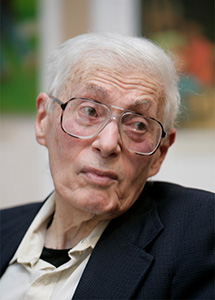
Robert Smullyan Sloan was born Robert Seymour Smullyan in New York City on December 5, 1915. He studied art at the City College of New York, graduating in 1936. He also studied art and art history at the Institute of Fine Arts at New York University, specializing in connoisseurship. His first job, during the years of the Great Depression, was as a WPA artist. After a sojourn in Paris in 1938, he began a career as a commercial illustrator, doing covers and features for such magazines as Time, Coronet, and Collier’s. Shortly after the United States entered World War II, he was commissioned to do a poster for the U.S. Treasury’s War Bond campaign (“Doing All You Can, Brother?”), earning a Citation for Distinguished Service.
He was drafted into the army in 1943, and from 1943 to 1946 he illustrated training manuals for the Army Education Program. In 1944 he painted the watercolor Station Hospital, which toured nationally with the National Soldier Art Show and later was exhibited at the National Gallery in Washington, D.C., winning third prize from among tens of thousands of entries. In 1948 his Negro Soldier (tempera and oil) was exhibited at the Corcoran Gallery Bicentennial and at the Carnegie International, where it won Honorable Mention.
After his discharge from the army in 1946, he resumed his career in commercial art until the studio for which he worked fell victim to the McCarthy era. To support his family, he turn turned to other art-related pursuits, including portrait painting, teaching, and art restoration, and appraisal. From the 1960s to the early 1980s, Sloan owned and operated an art gallery in Manhattan, specializing in works by early American and European masters. However, he never abandoned his first love of easel painting. Sloan had one-man shows at Leger Galleries, in White Plains, New York; Capricorn Galleries, in Bethesda, Maryland; the Herbert F. Johnson Museum of Art, at Cornell University; and the Instituto de Bellas Artes, in San Miguel de Allende, Mexico. In 1995 his painting Overpopulation won First Prize in the Modern Maturity Seasoned Eye National Art Competition. Sloan’s paintings are represented in many collections, including the National Portrait Gallery, Cornell University’s Herbert F. Johnson Museum, IBM, the Brooklyn Museum of Art, the Metropolitan Museum of Art, and Harvard’s Fogg Art Museum, which purchased Negro Soldier for its permanent collection in 2006. He is listed in Who’s Who in American Art.
Sloan and his late wife, Irene, lived in Mamaroneck, New York, for 56 years. For more than 25 years they wintered in San Miguel de Allende, Mexico, where he produced many of his paintings. In 2006 he and Irene moved to Duxbury, Massachusetts, where he lived until his death, from complications of a stroke, on November 30, 2013. For the last several years of his life he was legally blind. He left a son, a daughter, and four grandchildren.